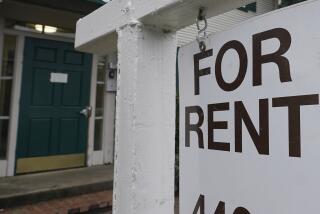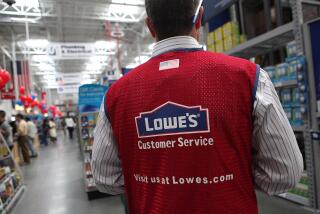Minority Programs Mostly Aid White Areas : Contracts: Only 22% of funds for Small Business Administration’s ‘set-aside’ program goes to companies in target areas.
- Share via
WASHINGTON — The government’s flagship program for minority entrepreneurs awarded $19 billion in contracts over the last six years, with the lion’s share going to firms whose headquarters were located in primarily white, well-to-do neighborhoods.
An Associated Press computer analysis of “minority set-aside” contracts handled by the Small Business Administration found that just 22% of the project dollars went to companies located in minority areas.
And those companies that qualified for the program while remaining in minority areas on average got fewer contracts and dollars than those in white areas, the analysis showed.
The SBA’s 8(a) program directs federal contracts to minority-owned companies for work ranging from computer processing to construction or custodial services. SBA has told Congress that one effect of these contracts has been to boost job opportunities in less prosperous city neighborhoods.
Yet to be more competitive, some business owners said they moved out of minority communities to get closer to their federal customers.
“I was (located) so far away from government installations, the SBA was reluctant to give me jobs,” said Samuel Hayes, who moved his construction company out of Benton Harbor, a city in southwestern Michigan where nine people in 10 are black.
Now his company, Rah Development, does business from Northville, Mich., in an area of the Detroit suburbs where half the households make more than $167,374 and nine people in 10 are white.
The program’s supporters say its goal is to foster minority businesses, not community development. And like any business, they say, minority companies need to locate near their customers. In the 1990s, that often means the suburbs.
“It’s a business decision, not a social decision as to the location,” said Cassandra Pulley, SBA deputy administrator. “It is not a program that is designed for economic development in black inner-city neighborhoods.”
The analysis of 8(a) contracts showed the average minority-contracting company is located in an area where 68% of the residents are white, half the households earn $37,415 or more, and only one person in seven is poor.
In contrast, most black Americans live in neighborhoods where minority residents are the majority and where half the households earn less than $24,550.
“A lot of truly small minority businesses which really would be the backbone of the minority community cannot get a quarter from the SBA,” said attorney H. T. Smith, organizer of a recently ended black tourism boycott in Miami.
When it comes to investing in minority communities, Smith believes, “as far as the government and the business community are concerned, that’s just throwing money away.”
There is no requirement that participants stay in minority neighborhoods or that they be poor. In fact, entrepreneurs can qualify with a net worth up to $250,000, excluding their home and business assets.
When SBA goes to Congress for funding, it presents the program as a business incubator that benefits impoverished minority communities.
“8(a) firms provided employment for over 102,000 men and women during fiscal 1992,” the agency said in its most recent report to Congress. “Many of these jobs are in the inner city and in areas of high unemployment.”
The AP analysis, however, suggests otherwise.
The study analyzed the contractors’ location by the ZIP code of their headquarters, using racial, ethnic and income information from the 1990 Census. AP reviewed almost 25,000 contracts covering $17.5 billion of the $19 billion awarded under the program from 1988 to 1993.
About $1.5 billion was not analyzed because there was no matching census information for the companies’ ZIP codes.
Contracts spanned the country, ranging in value from 12 cents to $96.2 million.
It was not possible to determine from the database where the companies did the contract work, and the SBA said it did not track the background of employees who worked on the 8(a) contracts.
Companies owned by blacks or Hispanics make up three-quarters of the program’s participants. However, the review found:
Only 9% of the 8(a) contract dollars went to businesses in black-majority neighborhoods.
* 4% went to Hispanic-majority neighborhoods.
* 9% went to neighborhoods with majority Asian, American Indian or mixed-minority populations.
* 7% of contract dollars went to neighborhoods with minority populations from 40% to 50%.
The largest bloc of 8(a) dollars--37%--went to companies in neighborhoods with fewer than 20% minorities. And three-fourths went to neighborhoods where the typical household income was more than $30,000.
Some contractors who remained in poor minority communities say they did so out of a sense of responsibility.
During the time she was in the SBA program, Florence Hicks Alexander kept the headquarters of her management consulting company in a mostly black neighborhood in Washington and located most of her 350 offices in minority neighborhoods across the country.
“We are very proud of what we did and how we did it,” she said. “I myself am a product of the ghetto. . . . I felt it was my responsibility to give back.”
Such businesses, however, get fewer and smaller contracts, the AP review found.
Businesses in primarily minority areas averaged seven contracts worth $589,594 each, compared to nine contracts worth $748,661 each for those in white communities.
Some see the program, a product of the civil rights movement, as mirroring a growing divide in minority communities between rich and poor, skilled and unskilled.
“You have a two-tier system that’s becoming more discernible in the black community itself,” said Elijah Anderson, sociology professor at the University of Pennsylvania. “The people who have the skills and education are being siphoned off by the corporate world. Those people are not starting inner-city businesses.”
Weldon Latham, of the National Assn. of Minority Business, defends the 8(a) program, saying critics wrongly view it as a “paternalistic” welfare initiative instead of a tool to help minorities break into the economic mainstream.
Participants say the decision on how many minorities they hire often depends on where the work is done.
“If I got a job in upper Appalachia, I’m going up there and hire me some white folks,” said James L. Harrell, an Alabama construction company owner and president of the 4,500-member National Assn. of Minority Contractors.
Some say there are other ways their companies help minority communities.
Singobee Builders Inc. in Loretto, Minn., is located in a 99% white neighborhood and has only five minorities among its 25 workers, but it subcontracts much of its work with minority firms, according to its chief officer, Gae Veit.
“The more successful minority businesses become, they automatically reach out to the minority business community,” said Veit, who is an American Indian.
But the Rev. Michael Pfleger, a Roman Catholic priest on Chicago’s largely black South Side, is skeptical.
“I look at the community I live in here, no businesses are opening up. You can’t get jobs. I’ve only seen a continual spiral downward,” he said.
BACKGROUND
The Small Business Administration’s minority contracting program was established in the late 1960s to assist entrepreneurs in racial and ethnic groups considered economically and socially disadvantaged by past prejudice. As individuals, however, most of the participants in the 8(a) program are anything but poor. The SBA says the 727 entrepreneurs who entered the program last year had an average personal net worth of $135,654, excluding their main residences and their stake in the business. The highest was $982,749. Almost half the participants in the program are black, about a fourth are Hispanic, one-fifth are Asian and 6% are Native American.
More to Read
Inside the business of entertainment
The Wide Shot brings you news, analysis and insights on everything from streaming wars to production — and what it all means for the future.
You may occasionally receive promotional content from the Los Angeles Times.










